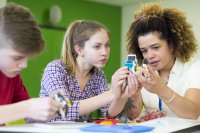Guiding Students to Science Literacy
A teacher, mentor, and curriculum writer shares her experience with the Engineering Practices in the Next Generation Science Standards.
Your content has been saved!
Go to My Saved Content.February 6, 2018, was a great day for science and one of my favorite teaching days ever.
At 12:45 the lunch bell rang, which usually gets students running for the door. But that day most of them stayed—to watch the launch of SpaceX’s Falcon Heavy. Excitement filled the room as the rocket blasted into space. What a powerful symbol of humankind’s ingenuity and curiosity. After the fuel boosters separated, most kids headed off to lunch with a “cool” or “awesome.”
A handful of students stayed on to watch as Falcon Heavy launched its payload, SpaceX CEO Elon Musk’s red Tesla Roadster, into space, “driven” by a robot called Starman—a beautiful and bizarre sight.
Four minutes later, those who remained saw the landing of two of the booster rockets. We all laughed with joy at the amazing, synchronized vertical double landing.
One student said, “They scienced the crap out of that.”
Another replied, “Actually, they engineered the crap out of that.”
My students had been paying attention. I beamed, wondering if my day could get any better.
Science and Engineering: Questions and Answers
It’s said that science asks questions (the scientific method) and engineering solves problems (the engineering design process). In order to have a truly inquiry-based science classroom, there must be both questions and answers. They may not all be the right questions and answers, but coming up with them takes students to true science literacy.
But we can’t simply tell our students to solve a problem—we must give them a structured process to do so.
The first time I encountered the Next Generation Science Standards, I was at a district-wide science staff development. Many teachers looked at the new standards and gasped.
“Wait. What? You want me to teach engineering? But I don’t have an engineering degree! I can’t even assemble Ikea furniture!”
Fair enough. The younger teachers were especially spooked. These were committed, hard-working teachers who wanted to do the best they could, and they felt unprepared for the new standards.
I knew, as a science teacher, mentor, and curriculum writer, that I needed to learn the NGSS Engineering Practices inside and out. I started with the common foundation that can be adapted for grades from kindergarten to 12th: the engineering design process. (KQED created a beautiful graphic to explain the process.)
I created a worksheet that I use for project-based learning, but it can be used in any problem-solving situation.
Steps of the Engineering Design Process
Define the problem: Scientists use the scientific method to make testable explanations and predictions. Engineers define a specific need. This may be stated as: Who needs what because why? Once a problem is identified, it needs to be researched: Is this really a problem that needs solving? Is there already a good solution? What have others done in the past?
Identify constraints: Students can be as specific or as general as they need to be in identifying constraints like time, budget, materials, and criteria for success.
This step is sometimes not seen in the engineering design process, but it’s important to be realistic about time and materials. For example, we can’t simply say we’re going to solve the problem of how to make our car go faster if we don’t have access to fuel, tools, and engine parts. We may need to just wake up earlier and start our journey sooner—in that case we haven’t made our car go faster, but we have solved the problem of getting to where we need to be on time.
This is a silly example, but it shows that identifying what we have to work with is crucial.
Brainstorm multiple solutions: This step is preferably done in groups because groups generate a larger number of ideas, but it can be done by individual students. Either way, they can’t rest with a single solution at this stage—this is the time for wild ideas, creativity, and building on other people’s ideas.
Select the most promising solution: Students should now review their possible solutions and identify the best one, keeping the constraints in mind. They should be able to say why their choice is best.
Prototype the chosen solution: This makes the idea come to life. Keeping the original problem in mind, have students push themselves to make the best prototype possible.
Test and evaluate the prototype: At this point, students begin to answer these questions: Does it work? Does it solve the problem? They should collect data and analyze: Does it work some of the time? All of the time? Why or why not?
Iterate to improve the prototype: This is redesign time.
Communicate the solution: Students report on whether they met with success or failure.
The engineering design process worksheet can be used for project-based learning, self-designed science inquiries—it can even be used in culinary class to find the best recipe for mac and cheese. Students will gain a strong foundation in engineering at its most practical.
It doesn’t matter if a student grows up to command a Mars mission or never takes another science class. We must make our children science and engineering literate. They’ll have to make good choices about what to buy, how to vote, what kinds of food to eat. Being science and engineering literate helps students know the real from the fake. It helps make them good critical thinkers and problem solvers. It gives them a sense of wonder at the world around them. It empowers them.
